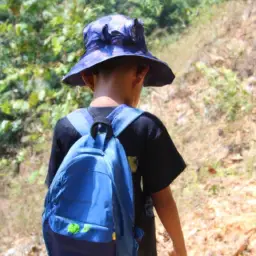Are you looking to develop your student’s leadership skills in education? One important factor to consider is the role of grit. Grit is the combination of passion and perseverance towards a long-term goal, and it has been found to be a key component in achieving success, especially in leadership roles.
By helping students cultivate grit, educators can set them up for success in their future leadership endeavors. Developing grit in students involves building their passion and perseverance towards their goals, as well as cultivating their resilience and ability to learn from failure.
By instilling these traits in students, educators can help them develop self-confidence and self-efficacy, which are essential qualities for effective leadership. Additionally, promoting collaboration and teamwork among students can further build their grit and prepare them for leadership roles where they will need to work with others towards a common goal.
With a focus on developing grit, educators can help students become successful leaders who are able to overcome challenges and inspire others to achieve their goals.
Key Takeaways
- Grit is a crucial personality trait in achieving success, especially in leadership roles.
- Developing grit in students involves building their passion and perseverance towards their goals, cultivating resilience, and ability to learn from failure.
- Project-based learning is an effective way to develop leadership skills, allowing students to take ownership of their learning and develop crucial skills.
- Assessing grit development programs is important to evaluate their effectiveness, and short-term and long-term outcomes should be considered when evaluating program impact.
What is Grit and Why is it Important in Student Leadership Development?
You can’t become a great student leader without grit – it’s the tenacity and resilience that propels you forward even when the going gets tough. Understanding grit’s connection to student success is crucial in developing effective leadership skills.
Grit is a personality trait that refers to an individual’s ability to persevere through challenges and maintain a sense of passion and resilience towards their goals. When applied to education, grit is an essential component of student success. Students who possess grit are more likely to overcome obstacles, develop resilience, and achieve their goals.
Strategies for promoting grit in the classroom include creating a growth mindset environment, providing opportunities for students to take risks and learn from their mistakes, and setting challenging but achievable goals. Teachers can also model grit by sharing stories of their own struggles and how they overcame them.
Encouraging positive self-talk and emphasizing the importance of effort over innate ability can also help students develop grit. By promoting grit in the classroom, students can develop the leadership skills necessary to achieve their goals and become effective leaders in their communities.
Developing Passion and Perseverance in Students
When you’re passionate about something, it fuels your motivation and drives you to succeed. Developing a grit mindset is crucial in helping students identify their passions and fostering the perseverance needed to achieve their goals.
Teachers can help students develop this mindset by incorporating strategies for grit development into their lessons. Here are four strategies for developing passion and perseverance in students:
- Encourage students to explore their interests and passions through projects and assignments that align with their goals.
- Teach students the importance of setting realistic goals and breaking them down into manageable steps.
- Provide opportunities for students to reflect on their progress and celebrate small milestones along the way.
- Teach students to embrace challenges as opportunities for growth and learning, rather than viewing them as obstacles.
By helping students develop a grit mindset, teachers can empower them to become leaders in their own right and achieve success in their academic and personal lives.
Cultivating Resilience and Learning from Failure
If you want to cultivate resilience and learn from failure, it’s important to understand that setbacks and mistakes are opportunities for growth and development. In fact, resilience building and failure learning go hand in hand. When students are able to bounce back from a disappointment or setback, they are more likely to persevere and succeed in the future.
One way to cultivate resilience is to teach students to reframe their thinking about failure. Instead of seeing it as a negative outcome, encourage them to view it as a learning experience. This can be done through reflective exercises, such as asking students to identify what they learned from a particular failure or setback. By shifting their perspective, students can begin to see the value in making mistakes and use them to inform their future actions.
| Resilience Building | Failure Learning |
|---|---|
| Emphasize effort over outcome | Encourage reflection on mistakes |
| Foster a growth mindset | Reward risk-taking |
| Model resilience and perseverance | Teach problem-solving skills |
By incorporating resilience building and failure learning into education, students can develop the grit needed to become strong leaders. They will be better equipped to handle challenges and setbacks, and will be more likely to persevere in the face of adversity. Encourage your students to embrace failure as an opportunity to grow, and watch as they become more resilient and successful.
Building Self-Confidence and Self-Efficacy
Building self-confidence and self-efficacy can be a fun and empowering experience for any learner. It involves building resilience and developing grit through challenges.
In order to empower students through self-reflection and goal-setting, educators can provide opportunities for students to set achievable goals and celebrate their successes. By recognizing their strengths and accomplishments, students can develop a stronger sense of self-confidence and self-efficacy.
In addition to setting goals, it’s important for students to reflect on their progress and identify areas where they can improve. Encouraging students to take ownership of their learning and become active participants in the learning process can help them develop a greater sense of self-efficacy.
By providing opportunities for reflection and self-assessment, educators can help students build their self-confidence and develop the skills they need to become effective leaders. Through these efforts, we can help students become more resilient, confident, and successful in their academic and personal lives.
Promoting Collaboration and Teamwork
As a student leader, you can foster positive relationships among your peers by encouraging collaboration and teamwork. Encourage peer support by creating a safe and supportive environment where everyone feels valued and respected.
Providing opportunities for group projects can also help develop teamwork skills and foster a sense of community within your school or organization.
Fostering Positive Relationships
You can easily cultivate positive relationships with your peers and mentors by showing genuine interest in their lives and actively listening to their thoughts and opinions. Fostering trust and creating safe spaces is essential in building these relationships, as it allows for open communication and vulnerability. Empathy building and active listening are also crucial in developing positive relationships, as they show that you value and respect the perspectives of others.
To foster positive relationships, start by making an effort to get to know your peers and mentors on a personal level. Ask them about their hobbies, interests, and goals, and actively listen to their responses. Additionally, be open and honest with them about your own life and experiences. This will create a sense of trust and safety, allowing for deeper connections to form.
Another way to build positive relationships is to practice empathy and active listening. When someone shares their thoughts or opinions, take the time to understand where they’re coming from and show that you value their perspective.
By fostering positive relationships, you’ll not only develop stronger leadership skills but also create a supportive community that will help you thrive in your educational journey.
Encouraging Peer Support
Encouraging peer support can greatly enhance your academic experience and create a positive learning environment. As a student leader, you can encourage your peers to participate in peer mentoring or group activities.
These activities not only provide academic support but also foster a sense of community and belonging. Peer mentoring involves pairing up students to help one another with academics or personal growth. This can be done through one-on-one sessions or in a group setting.
Group activities, on the other hand, allow students to work together on projects or assignments, which can develop leadership and communication skills. By promoting peer support, you can help create a culture of collaboration and growth, where students can feel comfortable asking for help and supporting one another.
Providing Opportunities for Group Projects
Now that you have established a supportive environment among your peers, it’s time to take the next step in developing your leadership skills. One effective way to do this is through project-based learning. This type of learning allows you to work collaboratively with your peers, providing you with the opportunity to exercise your leadership skills.
Through group projects, you will be able to develop your group dynamics skills such as communication, collaboration, and conflict resolution. These skills are essential in becoming a successful leader. Project-based learning also allows you to take ownership of your learning, encouraging you to set goals, plan and execute tasks, and reflect on your progress. As you work through the project, you will learn how to manage your time effectively, prioritize tasks, and delegate responsibilities. These are all crucial skills that will prepare you for leadership roles in the future.
| Benefits of Group Projects | How It Helps Develop Leadership Skills | ||
|---|---|---|---|
| Encourages Collaboration | Develops Communication Skills | ||
| Stimulates Creativity | Improves Decision-Making Abilities | ||
| Enhances Problem-Solving | Builds Confidence and Motivation | ||
| Fosters Responsibility | Develops Critical Thinking Skills | ||
| Improves Time Management | Encourages Delegation and Prioritization | Facilitates Collaboration and Teamwork |
Assessing and Measuring Grit
So, you wanna know more about assessing and measuring grit? Well, let’s start by discussing the importance of identifying grit indicators.
By doing so, educators and researchers can develop assessment tools that accurately measure a student’s level of grit. Once these tools are in place, it becomes easier to measure the impact of grit development programs and tailor them to the specific needs of each student.
Identifying Grit Indicators
You can easily identify indicators of grit that can be developed to enhance your leadership skills in education. Grit is often described as perseverance and passion for long-term goals, and it is a crucial trait in any successful leader. Identifying grit indicators can help you assess where you stand in terms of developing this trait and help you focus on areas that need improvement.
Below is a table that outlines some common grit indicators and how they relate to developing leadership skills in education. Use this as a guide to help you identify which indicators to focus on and how to measure their effectiveness. Remember that developing grit takes time and effort, but with dedication and perseverance, you can become a strong and effective leader in education.
| Grit Indicator | How it relates to Leadership Skills in Education |
|---|---|
| Persistence | Leaders need to be able to persevere through challenges and setbacks in order to achieve long-term goals. |
| Passion | Leaders who are passionate about their work are more likely to inspire and motivate others to achieve their goals. |
| Self-discipline | Leaders who have self-discipline are better able to prioritize tasks and manage their time effectively, which can lead to greater success. |
| Resilience | Leaders who are resilient have the ability to bounce back from setbacks and continue to work towards their goals, even in the face of adversity. |
Developing Assessment Tools
Let’s dive into how we can create assessment tools to track our progress in building the traits of a strong and effective leader. Assessment design is crucial in making sure that we are measuring the right things.
We need to determine the specific competencies and behaviors that we want to develop in our students and then create assessments that can measure progress towards those goals. Here are some tips to help you create effective assessment tools:
-
Start with clear learning objectives: Before designing any assessment, make sure that you have a clear understanding of what you want your students to learn. This will help you to create assessment items that are aligned with your goals.
-
Use a variety of assessment types: Different students have different learning styles and preferences. By using a variety of assessment types (e.g., multiple choice, short answer, essays, projects), you can cater to the different needs of your students.
-
Collect and analyze data: Once you have administered your assessments, it’s important to collect and analyze the data. This will help you to identify areas where your students are excelling and areas where they need more support.
-
Use assessment results to inform instruction: Finally, use the results of your assessments to inform your instruction. If you notice that many of your students are struggling with a particular concept, for example, you may need to revisit the topic and provide additional support.
By following these tips, you can create effective assessment tools that will help you to track your progress in developing the leadership skills of your students. Remember, assessment design and data analysis are key components of any successful educational program.
Measuring the Impact of Grit Development Programs
Measuring the impact of grit development programs can be a rewarding experience. It allows you to see how effective your program has been in developing your students’ grit and leadership skills. When evaluating the effectiveness of your program, it’s important to consider not only short-term outcomes but also its long-term impact on students.
To measure program effectiveness, you can conduct surveys, interviews, and focus groups to gather feedback from students, teachers, and parents. You can also track students’ progress over time by monitoring their academic performance and extracurricular activities.
By analyzing this data, you can identify strengths and weaknesses of your program and make necessary adjustments to improve its impact. Ultimately, measuring the impact of your grit development program can help you ensure that your students are equipped with the necessary skills to become successful leaders in their future endeavors.
Frequently Asked Questions
How do cultural and socio-economic factors impact the development of grit in students?
You can’t ignore the impact that cultural and socio-economic factors have on the development of grit in students.
Socio-economic obstacles like poverty and lack of resources can make it difficult for students to stay motivated and focused on their goals.
Cultural sensitivity is also important, as different cultural backgrounds may have different values and beliefs about what it means to be gritty.
Teachers and leaders need to be aware of these factors when working with students and find ways to support and empower them to develop grit despite these challenges.
It’s important to remember that grit is not a one-size-fits-all concept and that different students may need different levels of support and guidance to develop this important skill.
Can grit be taught or is it a trait that individuals are born with?
When it comes to the debate of nature vs nurture, the question of whether grit can be taught or if it is an innate trait is a common one.
While some individuals may naturally possess a higher level of grit, research has shown that it can also be developed and nurtured through intentional practice and support.
Additionally, there are various grit assessment tools that can help identify areas for improvement and track progress over time.
So, while some individuals may have a natural inclination towards grit, it’s not a fixed trait and can be developed through intentional effort and support.
What are some effective strategies for fostering grit in students who are disengaged or apathetic towards school?
If you’re struggling to motivate disengaged or apathetic students, there are several effective strategies you can try.
First, focus on developing a growth mindset by encouraging students to view challenges as opportunities for growth and learning. This can be done through activities that promote resilience, such as problem-solving exercises or group projects.
Additionally, using motivation techniques like rewards and recognition can help students feel more invested in their education. For example, offering praise or small prizes for completing assignments or participating in class can help boost motivation and engagement.
Overall, fostering grit in students requires a combination of mindset development and motivation techniques to help them overcome obstacles and achieve their goals.
How can educators balance the promotion of grit with the importance of self-care and avoiding burnout?
To balance promoting grit and self-care, it’s important to recognize the importance of boundaries. Encouraging students to persevere and develop grit is crucial, but not at the cost of their mental health and well-being.
As an educator, you can set an example by taking care of yourself and setting boundaries for work-life balance. This can include prioritizing time for relaxation, exercise, and socializing outside of work.
Additionally, incorporating mindfulness and stress-reducing activities into the classroom can help students develop self-care habits. It’s essential to remember that promoting grit and resilience does not mean ignoring the importance of self-care and mental health.
By balancing these two aspects, students can develop both strength and well-being.
Are there any potential negative consequences of overemphasizing grit in education, such as discouraging creativity or ignoring systemic inequalities that may hinder success for some students?
If you overemphasize grit in education, you may run the risk of discouraging creativity and ignoring systemic inequalities that may hinder success for some students.
When grit is overemphasized, students may feel that they need to conform to a certain mold in order to be successful, stifling their creativity and unique talents.
Additionally, systemic inequalities such as poverty, racism, and lack of access to resources may prevent some students from achieving success, no matter how much grit they possess.
Therefore, it’s important for educators to promote grit while also acknowledging and addressing systemic barriers to success.
Conclusion
Congratulations, you’ve reached the end of this article on the role of grit in developing student leadership skills in education. Hopefully, you’ve gained a better understanding of what grit is and why it’s important in helping students become effective leaders.
As you’ve learned, grit involves developing passion and perseverance, cultivating resilience and learning from failure, building self-confidence and self-efficacy, and promoting collaboration and teamwork. By incorporating these elements into their educational programs, schools can better equip their students with the necessary skills to tackle challenges and overcome obstacles in their personal and professional lives.
Assessing and measuring grit can also help students and educators identify areas for improvement and track progress over time. In conclusion, developing grit is essential for students to become successful leaders in any field.
By fostering a growth mindset and encouraging perseverance, schools can empower their students to become confident, resilient, and collaborative leaders who are capable of achieving great things. Remember, grit is not something that can be taught overnight, but with dedication and practice, anyone can develop this crucial trait and achieve their goals.









































































































